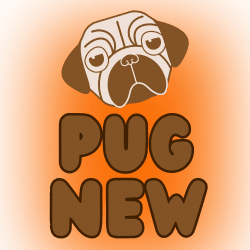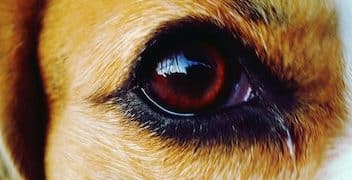Dental health for dogs: 3 simple steps to prevent gum disease and tooth loss

Anúncios
A healthy smile isn’t just for humans, your furry friend deserves one too. Ignoring their teeth can lead to hidden pain, gum disease, and even tooth loss.
Prioritizing dental health for dogs means more than fresh breath; it’s about protecting their happiness, comfort, and overall well-being for years to come.
Understanding canine gum disease and tooth loss
Gum disease, also known as periodontal disease, is alarmingly common in dogs, affecting over 80% of canines by the age of three.
Anúncios
This condition, often insidious in its progression, begins with plaque accumulation, which hardens into tartar if not removed.
The bacteria in plaque and tartar irritate the gums, leading to inflammation and, eventually, infection. Effective dental health for dogs routines can stop this process early.
Initially, signs might be subtle, such as slightly red gums. However, as the disease advances, it can cause significant pain, difficulty eating, and even systemic health problems.
Anúncios
The chronic inflammation can release bacteria into the bloodstream, potentially affecting vital organs like the heart, kidneys, and liver.
The stages of periodontal disease
Understanding the progression of gum disease is key to intervention. It’s not a sudden onset but a gradual deterioration of dental health for dogs, often unnoticed until it reaches advanced stages.
- Gingivitis (Stage 1): This is the earliest and most reversible stage. It involves inflammation of the gums, characterized by redness and mild swelling at the gumline. Plaque and tartar are present, but there’s no bone loss yet.
- Early Periodontitis (Stage 2): Progression sees the inflammation become more pronounced, with the start of bone loss around the teeth. Pockets begin to form between the gums and teeth, trapping more bacteria.
- Moderate Periodontitis (Stage 3): Significant bone loss occurs, along with deeper pocket formation. Teeth may become loose, and the dog might experience considerable pain. Infection is usually present.
- Advanced Periodontitis (Stage 4): At this severe stage, extensive bone and tissue loss threatens tooth stability. Multiple teeth may be extremely loose or already lost, and systemic health issues are highly probable due to bacterial spread.
Tooth loss is the ultimate consequence of untreated periodontal disease. As the supporting structures, gums, ligaments, and bone, degenerate, teeth lose their anchor and eventually fall out.
This not only impairs the dog’s ability to eat comfortably but also drastically reduces their overall quality of life.
Recognizing the early signs and understanding the potential severity of gum disease emphasizes the critical need for proactive dental health for dogs practices.
Far too often, owners become aware of the problem only when it has progressed to a painful and advanced state, requiring invasive and costly veterinary procedures.
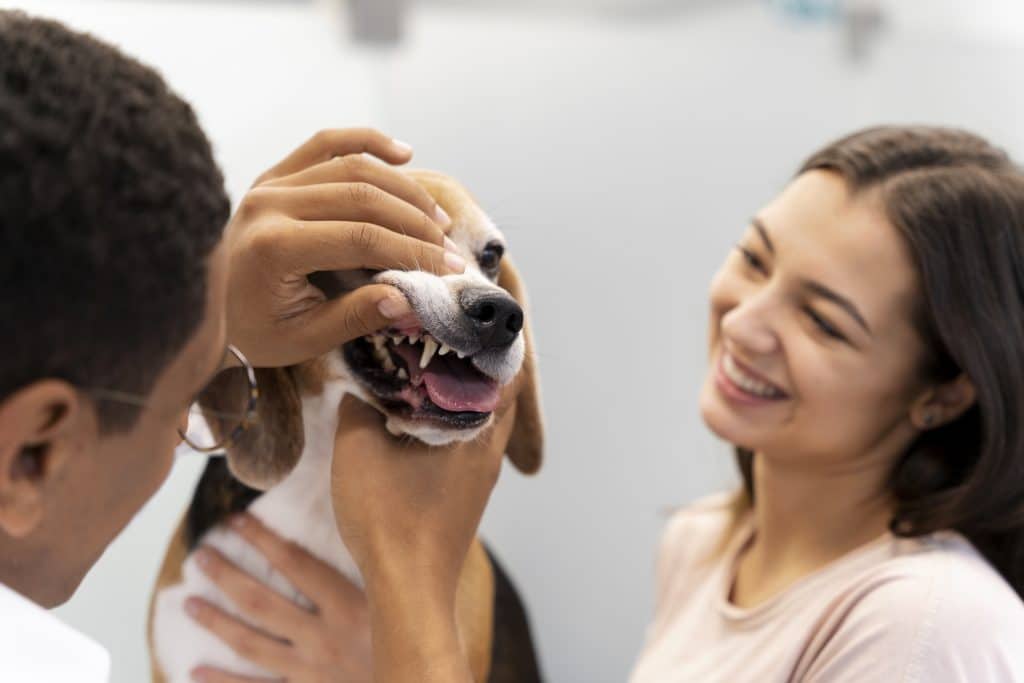
Step 1: The cornerstone of canine oral health (brushing your dog’s teeth)
Brushing your dog’s teeth is undeniably the single most effective method for preventing plaque and tartar buildup.
While it might seem daunting at first, with patience and consistency, most dogs can adapt to a regular brushing routine.
The key to dental health for dogs is to start early, make it a positive experience, and use the right tools. Just like humans, dogs accumulate plaque daily. This sticky film of bacteria adheres to the tooth surface.
If not removed, it mineralizes into tartar within 24–48 hours, which then requires professional cleaning to remove.
Daily brushing dislodges plaque before it hardens, significantly reducing the risk of gum disease.
Choosing the right tools and technique
Selecting appropriate dental tools is crucial for both effectiveness and your dog’s comfort. Avoid human toothpaste, as it contains ingredients that can be toxic if swallowed and foams excessively, which dogs dislike.
- Dog-Specific Toothpaste: These come in dog-friendly flavors like chicken, beef, or peanut butter, making the experience more palatable. They are also formulated to be swallowed safely.
- Dog Toothbrush: Options include finger brushes (good for puppies or sensitive dogs) or long-handled brushes designed with angled heads and soft bristles to reach all tooth surfaces.
Begin slowly and gradually introduce the toothbrush and toothpaste. Allow your dog to lick the toothpaste off your finger first.
Then, gently introduce the brush. Focus initially on the outer surfaces of the upper canines and molars, as these teeth tend to accumulate the most plaque.
The technique involves softly brushing in a circular motion, aiming for the gumline. Spend about 30 seconds per side of the mouth. The goal is to gently disrupt the plaque, not aggressively scrub.
Consistency is more important than duration, a few minutes daily is far more beneficial than an intense weekly session.
If your dog is resistant, break the process into smaller steps. Start by simply letting them lick the toothpaste. Then, gently rub their gums with your finger.
Gradually introduce the brush for short periods, praising and rewarding them throughout.
Over time, most dogs will tolerate, or even look forward to, their brushing sessions, especially if they associate it with positive reinforcement and the tasty toothpaste.
Establishing this daily habit is the most powerful preventative measure you can take against canine periodontal disease and to promote lifelong dental health for dogs.
Step 2: Dietary interventions and dental chews for oral health support
Beyond manual brushing, what your dog eats and chews can play a significant role in maintaining their dental hygiene.
Strategic dietary choices and the inclusion of appropriate dental chews can act as supplementary tools, helping to reduce plaque and tartar buildup naturally and support dental health for dogs.
While kibble is often perceived as inherently “cleaning” due to its abrasive nature, many regular crunchy foods offer minimal dental benefits.
The key lies in specially formulated dental diets and chews designed to mechanically scrub the tooth surface or chemically reduce plaque.
Dental diets and treat options
Some veterinary-approved dental diets feature unique kibble shapes and fiber configurations that physically abrade the tooth surface as the dog chews, reducing plaque and tartar.
These diets are often marked with a Veterinary Oral Health Council (VOHC) seal, indicating they meet specific standards for plaque and/or tartar control.
- VOHC-Approved Dental Diets: Look for dry food options specifically designed to scrape teeth clean, often containing a higher fiber content or a unique kibble structure. Discuss these options with your veterinarian.
- Dental Chews: These are a popular choice for many owners. The best dental chews are those that are appropriately sized for your dog, flexible enough not to damage teeth, and endorsed by the VOHC. They work by mechanical action, scraping plaque as the dog chews, and some also contain enzymes or ingredients to inhibit bacteria growth.
- Raw Bones (with Caution): While some advocate for raw bones, they carry significant risks of tooth fractures, choking, and bacterial contamination. If considering raw bones, consult your vet for safe options and supervised feeding. Never give cooked bones, as they can splinter.
When selecting dental treats or chews, it’s crucial to prioritize safety. Ensure they are digestible and won’t splinter or be swallowed whole, causing obstruction.
Avoid excessively hard chews like antlers or nylon bones, which can easily cause painful tooth fractures requiring expensive veterinary repair.
Dental water additives and oral rinses are also available. These contain ingredients that help break down plaque or reduce bacteria in the mouth.
While not a substitute for brushing, they can be a helpful addition to a comprehensive dental health for dogs routine, especially for dogs that are resistant to brushing.
Integrating these options into your dog’s routine can provide an ongoing, passive form of dental care. Remember, however, that these are supplementary.
They work best in conjunction with, not as a replacement for, regular brushing and professional veterinary oversight.
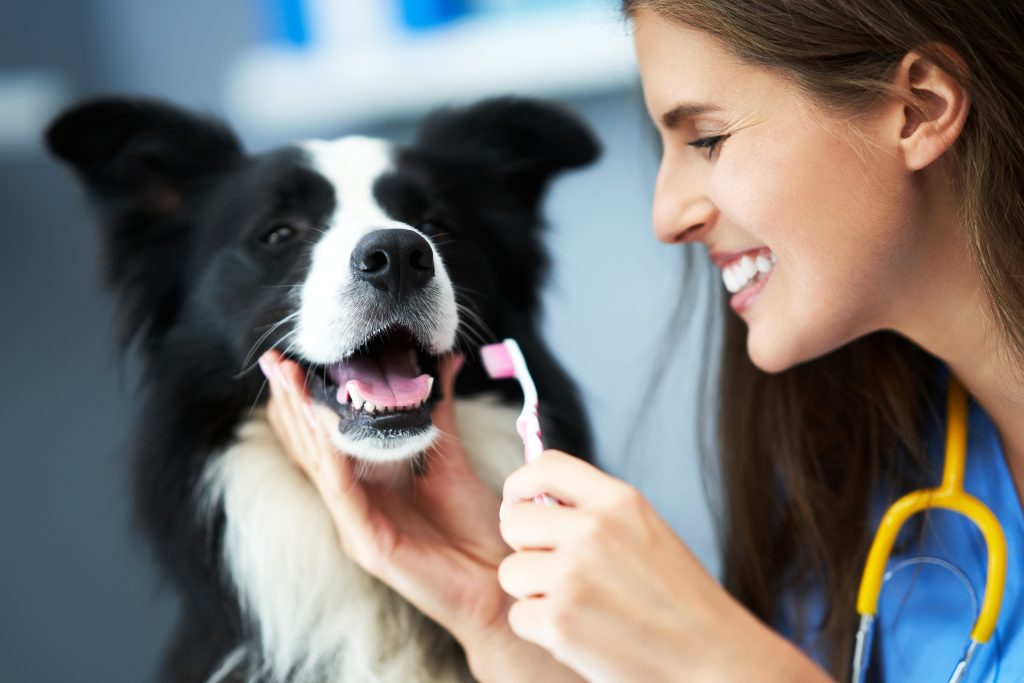
Step 3: The importance of professional veterinary dental cleanings and check-ups
Even with diligent at-home care, professional veterinary dental cleanings are an indispensable part of comprehensive oral hygiene for dogs.
Just as humans visit the dentist for deep cleanings, dogs require similar attention to address issues that at-home care cannot resolve.
These professional procedures are critical for preventing and managing advanced gum disease and tooth loss while maintaining overall dental health for dogs.
Professional cleanings allow veterinarians to thoroughly assess your dog’s oral cavity, identify underlying problems, and address plaque and tartar buildup below the gumline, an area inaccessible with a toothbrush.
These cleanings are performed under general anesthesia, ensuring the dog’s safety, comfort, and the veterinarian’s ability to conduct a meticulous examination and cleaning.
What a professional dental cleaning entails
A typical professional dental cleaning involves several key steps, all performed while the dog is under general anesthesia:
- Pre-Anesthetic Blood Work: To ensure the dog is healthy enough for anesthesia and to identify any potential risks.
- Oral Examination: A thorough examination of all teeth, gums, tongue, and other oral structures for signs of disease, damage, or abnormalities.
- Scaling: Using specialized ultrasonic and hand instruments to meticulously remove plaque and tartar from above and, critically, below the gumline. This subgingival cleaning is vital for addressing the root cause of periodontal disease.
- Polishing: After scaling, teeth are polished to smooth out any microscopic etches left by instruments, making it harder for plaque to adhere.
- Dental Radiographs (X-rays): These are essential for evaluating the health of the tooth roots and the bone supporting the teeth, revealing issues that are invisible to the naked eye, such as abscesses, bone loss, or unerupted teeth.
- Extractions (if necessary): If diseased or damaged teeth are identified, they may be extracted to eliminate sources of pain and infection.
The frequency of professional cleanings depends on your dog’s breed, age, genetics, and the effectiveness of your at-home care.
Some dogs may need annual cleanings, while others with excellent home care might only need them every few years.
Regular veterinary check-ups also provide an opportunity for your vet to assess your dog’s oral health during routine examinations.
They can offer guidance on appropriate dental products, demonstrate proper brushing techniques, and advise on when a professional cleaning might be necessary to maintain dental health for dogs at its best.
Ignoring professional dental care can lead to painful, chronic infections and necessitate more invasive procedures down the line.
Investing in regular veterinary cleanings is an investment in your dog’s long-term health and comfort.
Recognizing the warning signs: When to seek veterinary attention
While proactive care is paramount, knowing when to seek immediate veterinary attention for your dog’s dental health is equally critical.
Dogs are adept at hiding pain, and dental issues can progress silently, only becoming apparent when symptoms are severe.
Recognizing red flags can mean the difference between early intervention and advanced disease.
Key symptoms to monitor
Pay close attention to changes in your dog’s behavior, eating habits, and the appearance of their mouth. Any of these signs warrant a visit to your veterinarian for a thorough oral examination:
- Bad Breath (Halitosis): More than just “dog breath,” a foul odor often indicates the presence of bacteria associated with plaque and gum disease. It’s one of the earliest and most common indicators of a problem.
- Red, Swollen, or Bleeding Gums: Healthy gums are typically pale pink. Redness, swelling, or bleeding (especially during eating or when you touch their mouth) are classic signs of gingivitis or more advanced periodontal disease.
- Visible Tartar Build-Up: A brownish-yellow accumulation on the tooth surface, particularly near the gumline, is tartar. Once present, it can only be removed professionally.
- Changes in Eating Habits: Difficulty chewing, dropping food, chewing on one side of the mouth, or a sudden aversion to hard kibble or toys can signal oral pain.
- Changes in Behavior: Increased irritability, lethargy, reluctance to play with toys or be touched around the face, and pawing at the mouth can all be indicators of discomfort.
- Loose or Missing Teeth: This is a clear sign of advanced periodontal disease.
- Pus or Discharge around the Gums: Indicates a severe infection and warrants immediate veterinary care.
Even if your dog shows no obvious signs of discomfort, a routine dental check during their annual veterinary visit is vital.
Many dental problems develop gradually, and a veterinarian can often detect subtle changes before they become painful or severe. Early detection allows for less invasive and more effective treatment options.
Never attempt to remove tartar yourself, as this can damage tooth enamel and cause pain. If you notice any of these warning signs, schedule an appointment with your veterinarian promptly.
Timely intervention can save your dog from significant pain and prevent system-wide health complications stemming from untreated oral infections. Proper vigilance ensures long-term dental health for dogs.
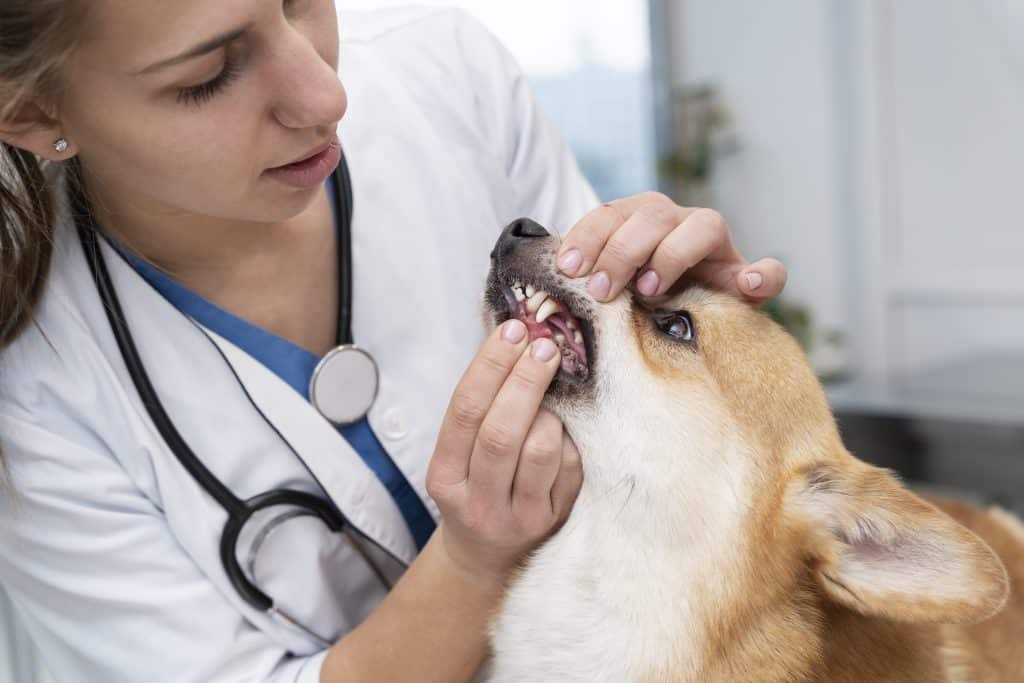
Debunking common myths about dental health for dogs
Misinformation about canine dental health is widespread, often leading owners to adopt ineffective practices or, worse, neglect essential care.
Separating fact from fiction is crucial for providing your dog with the best possible oral hygiene.
Understanding these common myths can help you make informed decisions about their dental regimen and protect overall dental health for dogs.
Myth 1: Dry kibble cleans my dog’s teeth
This is perhaps one of the most pervasive myths.
While crunchy kibble can offer a very minimal amount of surface abrasion, most dogs swallow their kibble quickly, without significant chewing action that would effectively scrape off plaque.
Regular dry kibble simply doesn’t clean teeth effectively, and in some cases, small fragments can even get stuck in crevices, contributing to plaque buildup.
Only specially formulated veterinary dental diets, with unique kibble shapes and fiber compositions (often VOHC-approved), are designed to provide a mechanical scrubbing action that helps reduce plaque and tartar.
Myth 2: Bad breath is normal for dogs
While often tolerated, bad breath (halitosis) is never truly “normal” for a dog.
It’s almost always a sign of an underlying oral health issue, most commonly bacterial overgrowth associated with plaque and tartar, gum disease, or even internal issues.
A dog with healthy gums and teeth should have relatively neutral breath.
Persistent bad breath is a strong indicator that a veterinary dental check-up is in order before the problem progresses.
Myth 3: Anesthesia for Dental Cleanings is Too Risky
While any anesthetic procedure carries a degree of risk, modern veterinary anesthesia protocols, coupled with pre-anesthetic blood work and continuous monitoring, have made dental cleanings under anesthesia remarkably safe.
The benefits of a thorough cleaning and examination, which can prevent painful tooth extractions and systemic infections, overwhelmingly outweigh the minimal risks for most healthy dogs.
Untreated dental disease often poses far greater health risks to an older dog than a carefully managed anesthetic procedure.
Your veterinarian will assess your dog’s individual health to determine the safest anesthetic plan and maintain optimal dental health for dogs throughout their life.
Myth 4: Dogs don’t need dental care until they’re older
Dental disease can begin in puppies as young as six months to a year. Plaque and tartar start accumulating from the moment permanent teeth erupt.
Waiting until a dog is older to begin dental care means that gum disease will likely be well-established and more difficult to treat, often requiring more extensive procedures.
Starting a home dental care routine (like brushing) when a dog is young, combined with regular veterinary check-ups, is crucial for lifelong oral health and sustainable dental health for dogs.
Dispelling these myths empowers dog owners to adopt more accurate and effective dental care strategies.
Prioritizing consistent, science-backed oral hygiene practices is the best way to ensure your dog enjoys a long, healthy, and pain-free life.
Integrating dental health into your dog’s daily routine: A holistic approach
Effective dental care for your dog should not be seen as an isolated task but rather an integral part of their daily routine, much like feeding and walking.
A holistic approach combines the three simple steps outlined, daily brushing, strategic use of dental aids, and regular professional oversight, into a seamless and consistent regimen.
This integrated strategy is the most reliable way to prevent gum disease and tooth loss, contributing significantly to your dog’s overall vitality and longevity through enhanced dental health for dogs.
Consistency is Key
The secret to successful canine dental health is consistency. Daily or every-other-day brushing is far more effective than sporadic intense sessions.
Plaque begins to form immediately after eating, and its removal needs to be a regular practice to prevent hardening into tartar.
Incorporate dental care into a specific time of day, perhaps after their last meal or before bedtime, to establish a predictable routine.
Making dental care a positive experience is also vital. Use plenty of praise, gentle handling, and palatable rewards. If your dog enjoys the process, they are far more likely to cooperate.
Even if full brushing is challenging, focus on the outer surfaces of the most susceptible teeth.
Beyond brushing, evaluate your dog’s diet. If they are prone to plaque buildup, consider incorporating a VOHC-approved dental diet or carefully selected dental chews into their feeding routine.
Remember that these are supplementary and do not replace the mechanical action of brushing.
Beyond the Brush: Lifestyle factors
Consider toys that can contribute to dental health. Chew toys designed to be durable and textured can help clean teeth as the dog plays, offering a fun way to physically abrade plaque.
Always supervise your dog with new toys to ensure they are safe and won’t break into pieces that could cause choking or intestinal blockage.
Finally, maintaining an open line of communication with your veterinarian is crucial.
They are your best resource for personalized advice on your dog’s specific dental needs, recommending appropriate products, and scheduling professional cleanings when necessary.
Regular check-ups allow for early detection of problems before they escalate.
By blending these components, consistent home care, supportive dietary choices, and professional veterinary attention, you create a robust defense against canine dental disease.
This holistic commitment to oral hygiene goes beyond preventing pain and tooth loss; it supports dental health for dogs in a way that enhances their entire systemic health, ensuring they can lead a comfortable, active, and happy life for many years to come.
Ultimately, a healthy mouth translates to a healthier, happier dog.
Investing the time and effort into dental health for dogs now will pay dividends in their long-term well-being and save you from potentially costly and uncomfortable interventions later on.
| Key Action | Brief Description |
|---|---|
| 🦷 Daily Brushing | Removes plaque before it hardens into tartar, the most effective home care method. |
| 🍖 Dental Chews/Diet | Supplements brushing by mechanically or chemically reducing plaque; look for VOHC approval. |
| Veterinarian Check-ups | Essential for professional cleaning, X-rays, and addressing issues below the gumline. |
| 👃 Monitor Signs | Watch for bad breath, red gums, or changes in eating behavior to detect problems early. |
Frequently Asked Questions (FAQ) about dental health for dogs
Ideally, you should brush your dog’s teeth daily. Plaque begins to form quickly, so daily removal is key to preventing its hardening into tartar. If daily brushing isn’t feasible, aiming for at least three times a week is still beneficial and significantly better than no brushing at all, even if less effective.
Common signs include persistent bad breath, red or swollen gums, bleeding from the gums, visible tartar buildup (brownish-yellow on teeth), difficulty eating, drooling, pawing at the mouth, and loose or missing teeth. If you notice any of these, consult your veterinarian.
Some dental chews can be effective as a supplement to brushing, but not a replacement. Look for chews approved by the Veterinary Oral Health Council (VOHC), which signifies they meet standards for reducing plaque and/or tartar. Always choose chews appropriate for your dog’s size and chewing habits to prevent choking or tooth damage.
Anesthesia allows the veterinarian to perform a thorough cleaning, including below the gumline, where most periodontal disease occurs. It also enables dental X-rays to assess root health and allows for safe extraction of diseased teeth. Anesthesia ensures the dog’s comfort, safety, and cooperation during a meticulous procedure.
Yes, absolutely. Untreated gum disease can lead to chronic pain and infection in the mouth. Bacteria from oral infections can enter the bloodstream and spread to other organs like the heart, kidneys, and liver, contributing to serious systemic health issues. Maintaining good dental health is vital for your dog’s entire body.
